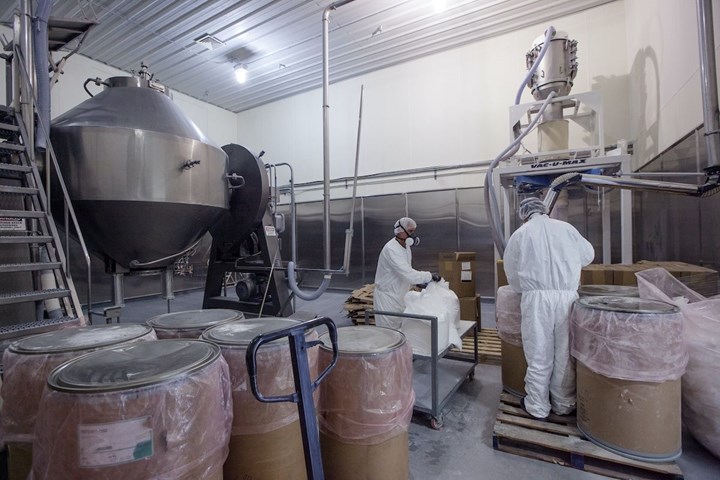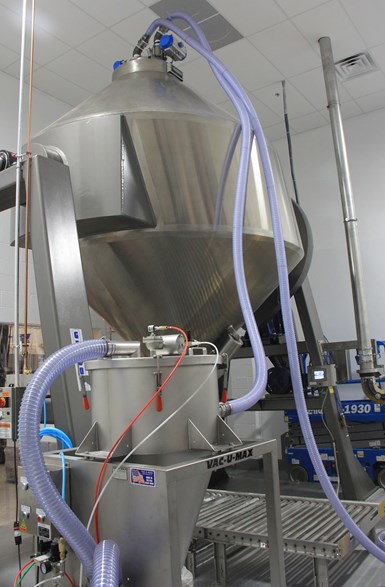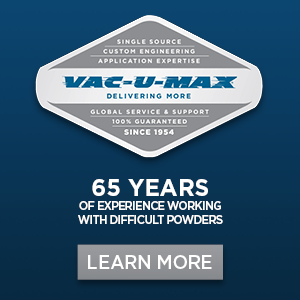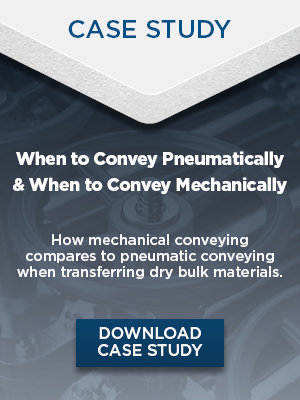Cut Loading Time Through Direct Charge Blending
Sponsored ContentDirect charge blender loading, a vacuum-powered automation process, can dramatically improve loading time and reduce material costs. In this article, we address ten common questions to help you determine if the systems are right for your facility.
Share
Read Next
While pneumatic conveying manufacturers are experts at moving powders and bulk solids, and blender manufacturers are experts at homogenizing powders and bulk solids, direct charge blender loading systems unite these two technologies while automating the process. Direct charge blender loading eliminates manual lifting of heavy bags, stair-climbing, and messy dumping of product into and out of tumbler blenders, while reducing the overall loading time of tumble blenders. By incorporating dilute phase vacuum conveying technology in your process, powders and other bulk materials are conveyed to tumble blenders at rates up to 6,000 pounds per hour – safer and more efficiently with no spills or waste.
For process engineers interested in the most efficient, consistent, and scalable powder and bulk material mixing solution, tumble blenders and dryers are statistically proven to provide the lowest standard deviation of all options. Today’s modern technological advances in vacuum conveying allow for safer and more efficient operations for applications requiring homogenized mixing while maximizing plant safety and OSHA compliance.
1. What is “Direct Charge Blender Loading”?
This unique adaptation of vacuum transfer, “direct charge blender loading,” uses a vacuum-tolerant process vessel like a tumble blender as the primary receiver of the powdered material charged to it. Material is vacuum-conveyed into and out of the process vessel automatically. This automated system loads and unloads pre- and post-blend bulk materials. Direct charge blender loading eliminates the vacuum receiver’s conventional loading and discharge cycle, transferring material into the blending process without spills and fugitive dust, keeping housekeeping at a minimum. With material transfer being completely automatic, there is no manual handling of the material, no operator exposure to dust or harmful materials, no ingredient loss or waste, and no product contamination. Material can be drawn from floor level via wand, from bulk bags, or up high from mezzanines. The system is packaged with timing controls and automatic pulse filter cleaning.
2. What are the loading and unloading options?
Direct charge loading technology allows for the vacuum conveying of powders and other bulk solids from various sources, whether a drum or bulk bag, and vacuum conveys the bulk materials to the blending vessel. Material can be conveyed from floor to mezzanine, and to upstream process equipment such as screeners or sieves. Once ingredients are blended, material is then vacuum conveyed out of the tumble blending vessel and conveyed to the preferred post-blend container. This vacuum transfer process is fast, secure, and simple. It reduces any chance of batch contamination, waste, loading time issues, or operator exposure to fugitive dust.
3. What types of materials can be vacuum transferred to a tumble blender?
The principal of vacuum transfer has been proven as a “better way” to move a wide range of powders and bulk materials, maximizing process efficiency by eliminating manual material handling. Considerations include material consistencies, moisture content, and/or particle size, but direct charge blender loading technology conveys virtually any dry powder or granular bulk material that can be vacuum conveyed through a hose or tube.
Powders can be conveyed from any ingredient container such as a drum or tote box, using a hand-held vacuum wand, or a bulk material device like a bulk bag unloader or bag dump station.
4. How are powders moved into and out of containers or into a process vessel?
The tumble vessel is the center of the mixing project, acting as the vacuum discharge receiver. Powders can be conveyed from any ingredient container such as a drum or tote box, using a hand-held vacuum wand, or a bulk material device like a bulk bag unloader or bag dump station, with material transferred through vacuum hose lines and discharged into the blender vessel. In reverse, the same material transfer vacuum lines can empty post-mix ingredients from the vessel and discharge them directly into the container(s) of choice. Inline filters on the direct charge blender loading system guarantee zero loss of material transfer between drum and vessel and prevent powder from collecting on the pump.
5. Are there any industry standards applied to direct charge blender loading technology?
Process vessel sizes and shapes should be designed and manufactured per USDA-sanitary design standards suitable for the food, beverage, pharmaceutical, nutraceutical and chemical industries. Blenders should be Mill-Certified, inspected, and American Society of Mechanical Engineers (ASME)-certified. Vacuum conveyors should be designed for cleaning and sanitation requirements for the industry being served.
All documentation and testing is consistent with standard cGMP (Current Good Manufacturing Practices) quality controls. Calibration and Material Certification(s) are also available.
Safety standards for combustible dusts (NFPA 652) and control of static electricity (NFPA 77) are also applied.
6. What seal options are available on vacuum tumble dryers?
There are two (2) seal options available, standard packing and/or a mechanical seal design.
The standard packing options are easy to install, with a lapped tolerance of less than one micron (0.00039 inches). Vacuum dryer systems have extremely low RPMs, making them better for packing.
The mechanical seal design is sensitive to installation errors so measurements must be precise. Any vibration or shaft deflection can cause catastrophic results. When cleaning and servicing the units, fluid can solidify, crystallize, or become viscous when the mixer/dryer is not running.
The mechanical seal design does not generate much heat and seldom requires cooling. Newer face materials and the latest elastomers are chemically compatible with a wide cross-section of chemicals and cleaners. Mechanical seals are better than packing when designing a high-speed shaft application.
Packing is best for slow-speed or high-temperature applications. Packing seals and mechanical seals will hold the same vacuum and maintain the same transfer leakage rate.

Vacuum tumble drying is approximately three times faster than tray drying.This approach provides low temperature drying for heat sensitive materials and allows for inert atmospheres without oxygen contact.
7. What do I need to know about vacuum tumble drying?
Vacuum tumble drying is approximately three times faster than a tray dryer. This approach provides low temperature drying for heat sensitive materials and allows for inert atmospheres without oxygen contact. Vacuum tumble-drying systems allow product mobility without segregation or classification of fines. Depending on the application, it can also provide low final moisture content, produce predictable, repeatable, and scalable results, and limit any potential for contamination. Additionally, the vacuum pump can be located in separate mechanical room, up to 500 ft (15m) away from the blender, saving floor space and noise in the blending suite.
8. What is the best blender vessel shape for drying: double-cone, slant-cone or V-shape?
The critical element in determining vessel shape for drying is the ratio between heated surface area inside the vessel and the volume of material load inside the unit. The lower the load level, the better the ratio and the faster the drying.
Albeit slight, double cone units have consistently larger surface areas versus V-shapes for the same working volume. However, the V-shape has a somewhat more significant advantage over double cones.
Slant cone units have slightly more surface area than similar double cone units. Accurate scale-up of tumble dryers is possible using this ratio. As the ratio goes down with larger units (more material, less surface area), the time required to dry will increase.
9. What is a dummy hose station?
A dummy hose station is for operator safety. A direct charge loading system may be equipped with optional dummy hose stations. These devices are wired to the blender control panel and integrated into the loading sequence programming. When blender loading is completed, operators must connect both the vacuum hose and convey hose to the respective dummy hose station.
Each hose station is designated for a different sized hose to prevent a mismatch. If both vacuum hoses are connected correctly, the blender can begin tumbling. If one or both vacuum hoses are not connected, or connected incorrectly, the operator will be prompted to correct the hose connections before the tumbling will be permitted.
A dummy hose station also provides a sanitary benefit by closing off the end of the hose when not in use, discouraging dropping the hose couplers on the floor which may damage the coupler or ferrule.
10. Does direct charge blender loading require any routine maintenance?
Direct charge blender loading technology automates blender loading by eliminating manual lifting and dumping. It is important to inspect convey hoses after each use and check for leaks of powder due to internal or external abrasion or excessive bending. Since this technology incorporates dilute phase vacuum conveying (not pressure conveying), any leaks are inward. Other routine maintenance includes inspection of dust filter(s) on the blender loader filter separator, and inlet adaptor on the front of the blender loader filter separator. Clean the interior of the blender loader filter separator in accordance with your sanitation and quality control procedures. This may be as frequent as following each usage, or simply when the ingredients in the blend are changed. On a quarterly basis, inspect the polytube compressed air tubing for leaks or any loose connections, as well as the ports on the vacuum vent valve.
One System with Homogenized Results
Direct charge tumble blender loading eliminates the vacuum receiver’s conventional loading and discharge cycle. The system transfers all material in and out of the tumble blending vessel without spills and fugitive dust, keeping everyone safe, clean, and housekeeping at a minimum. Material transfer, and precise blending and drying are all completely automatic, with no manual handling of the material, no operator trying to figure out blending times or recipes, no operator exposure to dust or harmful materials, no ingredient loss or waste, and no contamination. Material can be drawn from floor level via hose or tubing, from bulk bags, or mezzanines and discharged into the tumble mixer or dryer. The system is packaged with timing controls and automatic pulse filter cleaning. Controls for mixing and drying, and controls for the vacuum pump can all be remotely located and monitored.
For more information about vacuum conveying and direct charge tumble blender loading visit www.vac-u-max.com or www.okgemco.com.




